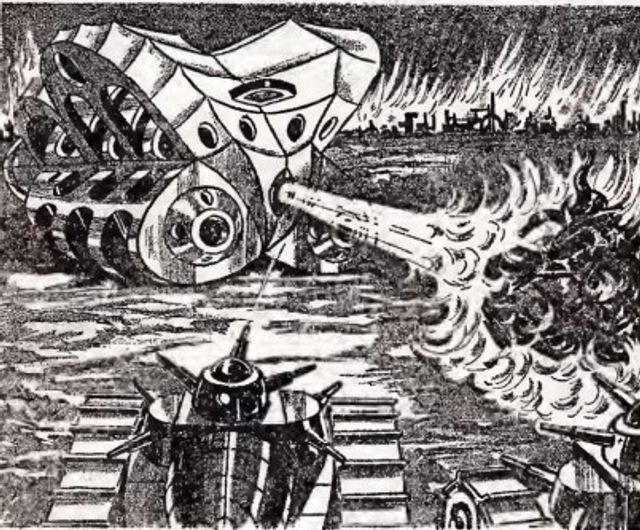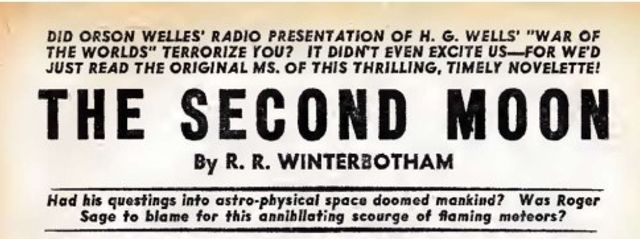-
Vijay Fafat
- Published on
This is one wreckage of a story; bad pulp fiction written way back when. It does have one or two decent points for an alert reader, like the observation that the presence of complex numbers in physical equations might indicate oscillatory phenomena, and that certain equations in physics throw up multiple solutions, all of which may be valid even if some appear unphysical (I was reminded of Dirac’s discovery of the theoretical existence of positrons in a similar manner)
Roger Sage was a science genius who had a theory about the origins of the solar system which involved a mysterious and difficult equation involving “the Sage Constant” (which is just the reciprocal of the speed of light but made much heavy weather of by the author, including a long footnote pretending to act as a deep physical explanation). According to this theory, Earth was predicted to have a second moon, roughly the size of earth itself, but obviously missing in action - an embarrassment for the theory. Till a strange meteor shower implied, through a tortuous development of narration by the author, that the second moon was a twin earth called “Irti” whose inhabitants had just launched a war against earth since their own planet occupied an unstable space in the fourth dimension. Despite all their scientific advancement, they needed Sage’s help with the subtler points of his theory to successfully complete their invasion (roll eyes). Under threat of blackmail, Sage and a French physicists, M. Billiones, pretended to help the Irtians but turned the tables on them by using an inverted equation which flipped the signs (or some such nonsense).
Since a mathematical equation is at the centre of everything which happens in the story, it appears inescapably as “mathfiction”, but a rather sorry example of one… A few extended excerpts:
“Exib led his captives inside the dimension traveler. Susan and Billiones were taken to comfortable quarters while Roger was led to a laboratory. On the wall of the room into which Roger was taken was a huge chart, covered with mathematical symbols.
“There, Dr. Sage,” said Exib, “are the mathematical calculations as far as we have been able to take them.” Roger scanned the chart. The equation carried the Sage constant, represented by the symbol S. Another well-known constant used was the “I” constant, known in mathematics as the square root of minus 1. This constant theoretically represents the difference between time geometry and space geometry—a warning signal in any equation to look out for waves and oscillations. Two other abstractions in the equation, X and Y, represented the unknown wave lengths to be used in the destruction of the Earth.
The final summation on the chart was the equation:
S. X. I^2 . Y = Q.
“The only aid we can give you in solving the values for X and Y is the fact that we know that one of the values must represent one-half the distance between Irti and the Earth?”
“As you know,” said Roger, “multiplication of wave forces of hyperga causes destruction of matter on the Earth, while division causes creation of energy. May I ask if this holds true on Irti?”
“Just the opposite,” declared Exib.
“On Irti multiplication causes creation of energy and division causes destruction. It has led us to believe that the creation of energy is simply the transformation of matter from the Earth’s dimension, into energy on Irti’s plane.”
“I suspected as much,” Roger nodded. “Therefore, if we wrote the equation: S/X/P/Y, it would mean not the destruction of Earth, but the destruction or Irti and all creatures of its spatial structure, including you on Earth?”
“Yes,” agreed Exib, “for although we exist in your dimension ,our bodies are attuned to hyperspace and a reversing of the processes would destroy us, providing of course the correct wave lengths were used. But you need not plan our destruction, Dr. Sage. You will be watched carefully and your mathematics will be studied by our greatest minds.”
[…]
“Billiones was drawing figures on the tablecloth with his pencil as they talked. At first he drew triangles, then he drew squares, then a row of crosses. Finally he put a row of figures across the table and abstractly multiplied them. Roger watched him closely. Suddenly the American let out a whoop of joy. He seized the tablecloth and jerked it from beneath the dishes.
“There!” cried Roger. “That is an illustration of my point. Without even thinking, M’sieur Billiones, you have saved the world!”
“I? Wh-what have I done?” “You have solved a difficult irreversible equation,” smiled Roger. “We Americans call abstract scribbling such as you have been doing, ‘doodling.’ It is a common habit, but psychologists make a great deal of it, and have even gone so far as to classify various types of doodlers. You have solved the equation and you have saved the world, but you don’t know what you have done.”
[…]
“The Sage constant,” he hissed. “Value, .00000537!” Roger interrupted. “Of course you have taken precautions for the safety of we three human beings?”
“The ship will act as a shield,” said Exib. “It is impervious to everything but the oscillatory geometries that would destroy Irti.”
The motors in the room were screaming. Exib twisted the dial again.
“Multiply the first wave length—value .5. Result, .000002685.
Next the imaginary constant—the square root of minus one, squared value, minus one. Multiplied by .000002685. Result, minus .000002685.”
The motors reached a higher note. The air seemed charged with tension. “The final step. The second wave length, Y, value 2, multiplied by the result of the last operation, minus .000002685. Result, minus—
The thunder of a thousand storms shook the universe. There was a whirl of dust, a burning stench, screams of the Irti men. Roger closed his eyes. Then, suddenly as the noise arose, it quieted. The American opened his eyes. He was standing in a peaceful valley near a deep excavation. The dimension traveler, the disintegrating machinery, all of the machines of Irti had vanished.
[…]
“Let me congratulate you. You saved the world. It was not the method of calculating multiplication or division — that counted. But the final result. In the case of that equation the final result would have been the same, whether the numbers were multiplied or divided.”
“I do not understand.” M. Billiones stared at the American.
[…]
“Roger wrote with a stick on the ground. 0.00000537 X -5 X (—1) X 2 = —.00000537
“Now we divide:”
(A) 00000537 / 0.5 = 0.00001074
(B) 0.00001074 / (-1) = -0.00001074
(C) -0.00001074 / 2 = -0.00000537.\
“In both cases the answer is the same—the negative Sage constant. The negative sign indicated energy and I was certain energy would be created, not destruction of matter. In the creation of energy Irti and all dwellers of that planet were destroyed.”
“But how—how did I solve that problem?” asked Billiones.
“Abstractly you wrote down the following four figures 3 , 2 , i, i/2. Then you multiplied the four, your answer was three; you divided the four, your answer still was three.”
“Why?” asked Susan.
“Because two times one times one half is the same as saying one times one. And two divided by one divided by one-half is the same as saying one divided by one is one. By substituting my Sage constant for the number 3, I had practically the same equation you had written on the tablecloth.”

